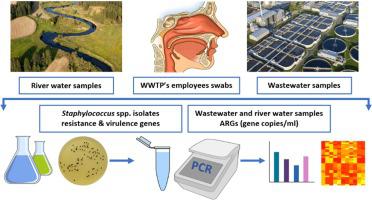当前位置:
X-MOL 学术
›
Environ. Int.
›
论文详情
Our official English website, www.x-mol.net, welcomes your
feedback! (Note: you will need to create a separate account there.)
The prevalence of drug-resistant and virulent Staphylococcus spp. in a municipal wastewater treatment plant and their spread in the environment
Environment International ( IF 10.3 ) Pub Date : 2020-06-29 , DOI: 10.1016/j.envint.2020.105914 Wiktor Zieliński 1 , Ewa Korzeniewska 1 , Monika Harnisz 1 , Jakub Hubeny 1 , Martyna Buta 1 , Damian Rolbiecki 1
Environment International ( IF 10.3 ) Pub Date : 2020-06-29 , DOI: 10.1016/j.envint.2020.105914 Wiktor Zieliński 1 , Ewa Korzeniewska 1 , Monika Harnisz 1 , Jakub Hubeny 1 , Martyna Buta 1 , Damian Rolbiecki 1
Affiliation

|
Drug-resistant and pathogenic spp. strains can reach surface waters and air with wastewater evacuated to the environment. These strains increase the environmental pool of genetic determinants conferring antibiotic resistance and virulence, and constitute a health risk for the employees of wastewater treatment plants (WWTP) who come into daily contact with bioaerosols. The aim of this study was to identify the genetic determinants of drug resistance and virulence in spp. strains isolated from untreated (UWW) and treated wastewater (TWW), an activated sludge (AS) bioreactor, river water collected upstream and downstream from the wastewater discharge point (URW and DRW), and WWTP employees. All isolates were analysed for the presence of the B gene, and were subjected to clonal analysis by ERIC fingerprinting. As a result, 249 of the 455 analysed isolates were selected for PCR. The presence of the gene encoding nuclease activity in (), the methicillin resistance gene A), vancomycin resistance gene (A), antiseptic resistance gene (A/B) and virulence genes (X, , , , sec) was determined. The prevalence of , A, A and A/B genes in wastewater and river water was determined by quantitative PCR (qPCR). In the group of strains isolated from wastewater and water samples, 63% were identified as , and 20% of the strains carried the A gene. The virulence gene was present in 80% of the isolates, and the gene was detected in 27% of the isolates. In the group of strains isolated from the employees, 82% were identified as , and the presence of A and A genes was confirmed in 14% and 16% of the isolates, respectively. The most prevalent virulence gene was (74%), whereas was observed in 43% of the isolates. The quantitative analysis revealed the highest concentrations of the studied genes in UWW samples, at 2.56x10 gene copies/ml for , 1.18x10 gene copies /ml for A, 8.28x10 gene copies /ml for A and 3.83x10 gene copies /ml for A/B. Some of analysed genes were identified in the isolates from both URW and DRW samples, as well as in genomic DNA of these samples. These results indicate that wastewater is not effectively treated in the analysed WWTP, which could contribute to the dissemination of antibiotic resistance genes (ARGs) and antibiotic-resistant bacteria (ARB) to the environment. An analysis of the genetic relatedness of selected isolates revealed clusters of strains originating from UWW samples, AS samples and the employees. These observations suggest that ARGs and ARB are transmitted by wastewater bioaerosols to the upper respiratory tract mucosa of the plant’s employees, thus increasing their exposure to infectious factors.
中文翻译:

耐药性和强毒力葡萄球菌的流行。城市污水处理厂及其在环境中的传播
耐药和致病菌种。菌株可以到达地表水和空气,废水则排入环境中。这些菌株增加了赋予抗生素耐药性和毒力的遗传决定因素的环境库,并对日常接触生物气溶胶的废水处理厂 (WWTP) 员工构成健康风险。本研究的目的是确定细菌耐药性和毒力的遗传决定因素。从未经处理的废水 (UWW) 和已处理的废水 (TWW)、活性污泥 (AS) 生物反应器、废水排放点上游和下游收集的河水(URW 和 DRW)以及污水处理厂员工中分离出的菌株。分析所有分离株是否存在 B 基因,并通过 ERIC 指纹进行克隆分析。结果,从 455 个分析分离株中选择了 249 个进行 PCR。测定了()中编码核酸酶活性的基因、甲氧西林抗性基因A)、万古霉素抗性基因(A)、抗菌剂抗性基因(A/B)和毒力基因(X、、、、、sec)的存在。通过定量 PCR (qPCR) 测定废水和河水中 、A、A 和 A/B 基因的流行率。从废水和水样中分离出的菌株中,63%被鉴定为A基因,20%的菌株携带A基因。 80%的分离株中存在毒力基因,27%的分离株中检测到该基因。在从员工身上分离出的菌株中,82%被鉴定为 ,并且分别在 14% 和 16% 的分离株中确认存在 A 和 A 基因。最普遍的毒力基因是 (74%),而在 43% 的分离株中观察到。定量分析显示 UWW 样品中所研究基因的浓度最高,为 2.56x10 基因拷贝/ml,A 为 1.18x10 基因拷贝/ml,A 为 8.28x10 基因拷贝/ml,A 为 3.83x10 基因拷贝/ml /B。在 URW 和 DRW 样品的分离株以及这些样品的基因组 DNA 中鉴定出了一些分析基因。这些结果表明,所分析的污水处理厂中的废水没有得到有效处理,这可能导致抗生素抗性基因(ARG)和抗生素抗性细菌(ARB)向环境中传播。对选定分离株的遗传相关性分析揭示了源自 UWW 样本、AS 样本和员工的菌株簇。这些观察结果表明,ARG和ARB通过废水生物气溶胶传播到工厂员工的上呼吸道粘膜,从而增加了他们接触感染因素的机会。
更新日期:2020-06-29
中文翻译:

耐药性和强毒力葡萄球菌的流行。城市污水处理厂及其在环境中的传播
耐药和致病菌种。菌株可以到达地表水和空气,废水则排入环境中。这些菌株增加了赋予抗生素耐药性和毒力的遗传决定因素的环境库,并对日常接触生物气溶胶的废水处理厂 (WWTP) 员工构成健康风险。本研究的目的是确定细菌耐药性和毒力的遗传决定因素。从未经处理的废水 (UWW) 和已处理的废水 (TWW)、活性污泥 (AS) 生物反应器、废水排放点上游和下游收集的河水(URW 和 DRW)以及污水处理厂员工中分离出的菌株。分析所有分离株是否存在 B 基因,并通过 ERIC 指纹进行克隆分析。结果,从 455 个分析分离株中选择了 249 个进行 PCR。测定了()中编码核酸酶活性的基因、甲氧西林抗性基因A)、万古霉素抗性基因(A)、抗菌剂抗性基因(A/B)和毒力基因(X、、、、、sec)的存在。通过定量 PCR (qPCR) 测定废水和河水中 、A、A 和 A/B 基因的流行率。从废水和水样中分离出的菌株中,63%被鉴定为A基因,20%的菌株携带A基因。 80%的分离株中存在毒力基因,27%的分离株中检测到该基因。在从员工身上分离出的菌株中,82%被鉴定为 ,并且分别在 14% 和 16% 的分离株中确认存在 A 和 A 基因。最普遍的毒力基因是 (74%),而在 43% 的分离株中观察到。定量分析显示 UWW 样品中所研究基因的浓度最高,为 2.56x10 基因拷贝/ml,A 为 1.18x10 基因拷贝/ml,A 为 8.28x10 基因拷贝/ml,A 为 3.83x10 基因拷贝/ml /B。在 URW 和 DRW 样品的分离株以及这些样品的基因组 DNA 中鉴定出了一些分析基因。这些结果表明,所分析的污水处理厂中的废水没有得到有效处理,这可能导致抗生素抗性基因(ARG)和抗生素抗性细菌(ARB)向环境中传播。对选定分离株的遗传相关性分析揭示了源自 UWW 样本、AS 样本和员工的菌株簇。这些观察结果表明,ARG和ARB通过废水生物气溶胶传播到工厂员工的上呼吸道粘膜,从而增加了他们接触感染因素的机会。











































 京公网安备 11010802027423号
京公网安备 11010802027423号